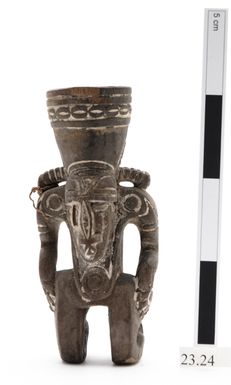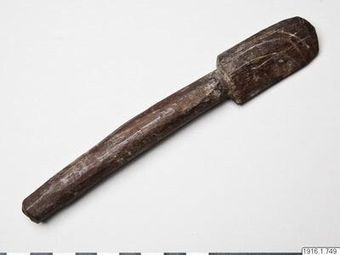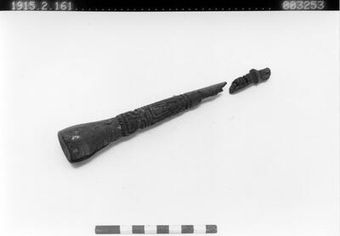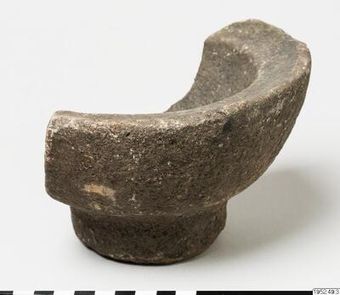Connect with Horniman Museum and Gardens
Contact this content partner to get more information about this item.
mortar (food processing & storage)
- Description:
- Betel Nut Mortar, Probably Tami Island, Huon Gulf, Morobe Province, Papua New Guinea. The chewing of the addictive stimulant Areca nut, commonly known as betel nut, was widespread among Melanesian men, and those of north-eastern Papua New Guinea were no exception. While younger men with good teeth had no problems chewing the nuts with powdered lime to activate their active ingredient Arecoline, older men often struggled in this regard. Little wooden mortars for grinding the betel nuts were a solution to this problem throughout New Guinea, and men used little stone pestles in such mortars to grind up the nuts before chewing. As with all of the paraphernalia of betel use throughout Melanesia, these portable little mortars became significant works of art, as this Huon Gulf example illustrates. Here we see the same strongly composed human figures distinctive of the bowls and other objects produced by the famous Tami island carvers. However, this example finds a three-dimensional way to represent the same artistic elements, twisting the human figure into a wonderful contortion that matches the needs of this practical object. Wood. Early 20th Century. Formerly in the private collection of Mr Frank Hanlin. Wooden areca-nut mortar, carved in the shape of a human figure.
- Format:
- image
- Collections:
- Horniman Museum and Gardens
- Content partner:
- Horniman Museum and Gardens
- Availability:
- Not specified
-
Copyright status: All rights reservedFind out more about what you are able to do with this itemThis item is all rights reserved, with means you'll have to get permission from Horniman Museum and Gardens before using it. For more information, please see our use and reuse page.More informationHorniman Museum and Gardens has this to say about the rights status of this item:
http://rightsstatements.org/vocab/InC/1.0/
What can I do with this item?Non-infringing useNZ copyright law does not prevent every use of a copyright work, and this item may be hosted by an international institute or organisation. You should consider what you can and cannot do with a copyright work.No sharingYou may not copy and/or share this item with others without further permission. This includes posting it on your blog, using it in a presentation, or any other public use.No modifyingYou are not allowed to adapt or remix this item into any other works.No commercial useYou may not use this item commercially.
Welcome and warm Pasifik greetings
The information on this site has been gathered from our content partners.
The names, terms, and labels that we present on the site may contain images or voices of deceased persons and may also reflect the bias, norms, and perspective of the period of time in which they were created. We accept that these may not be appropriate today.
If you have any concerns or questions about an item, please contact us.



